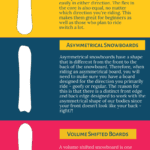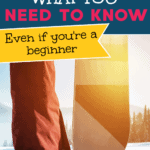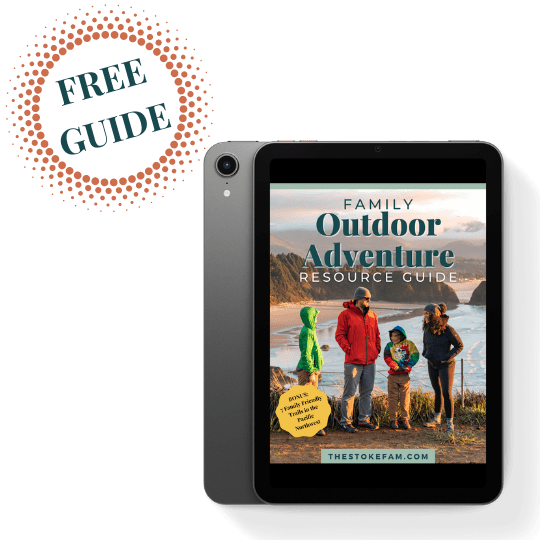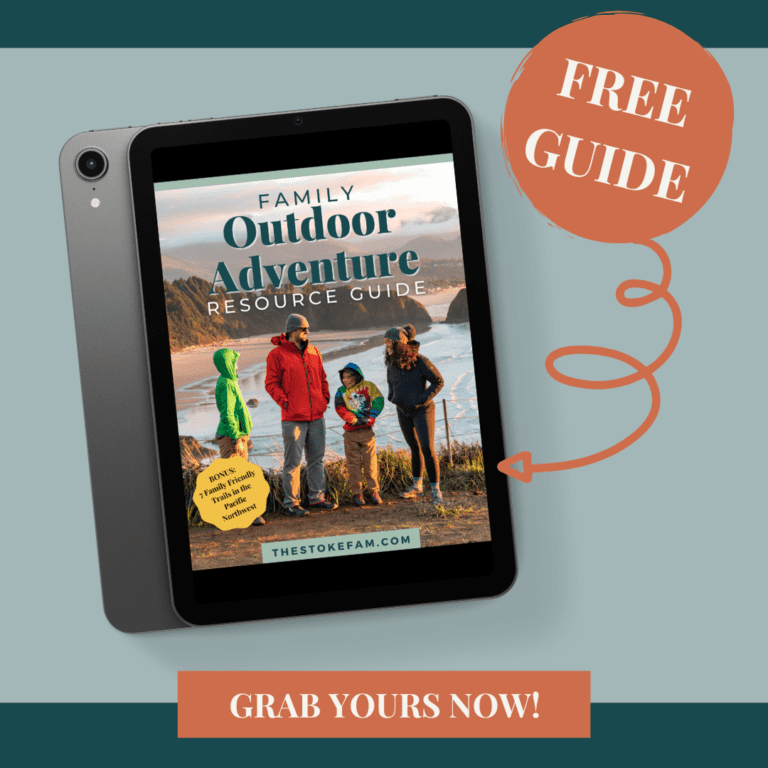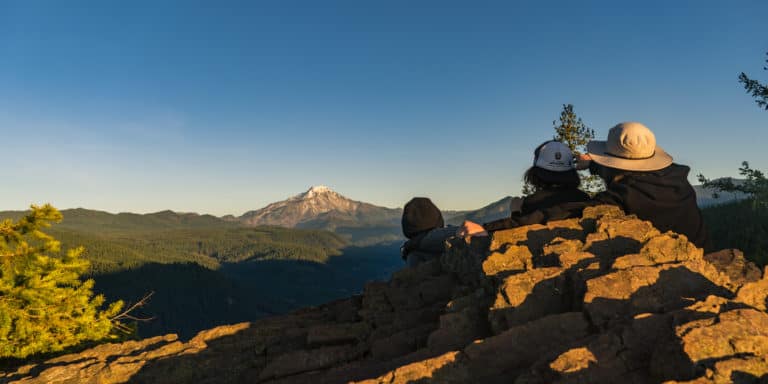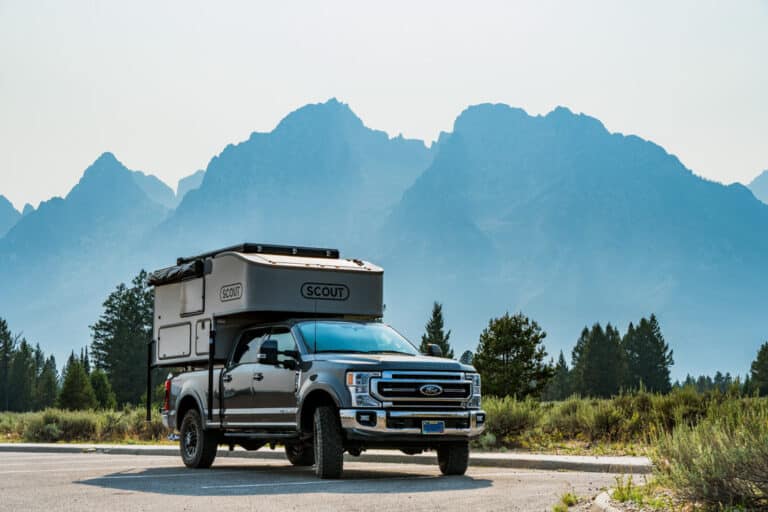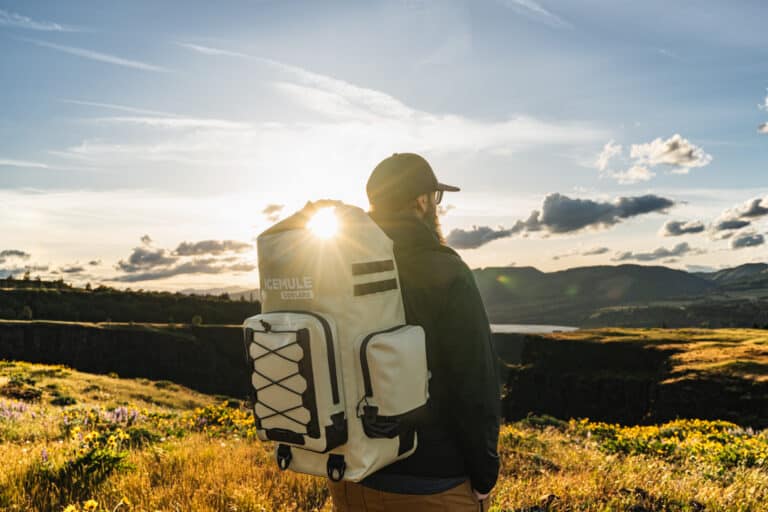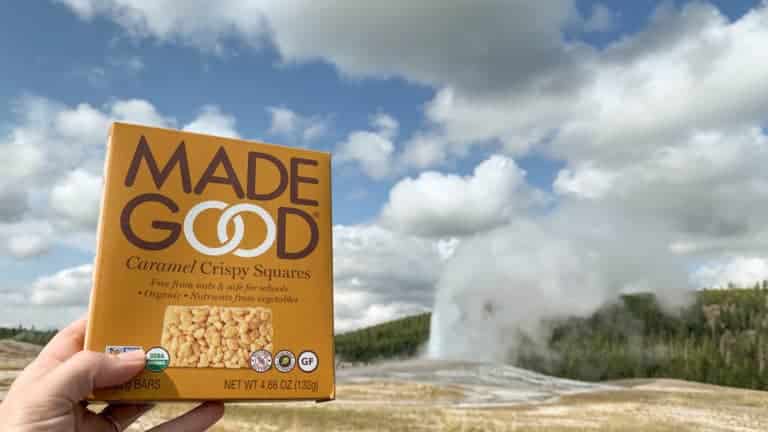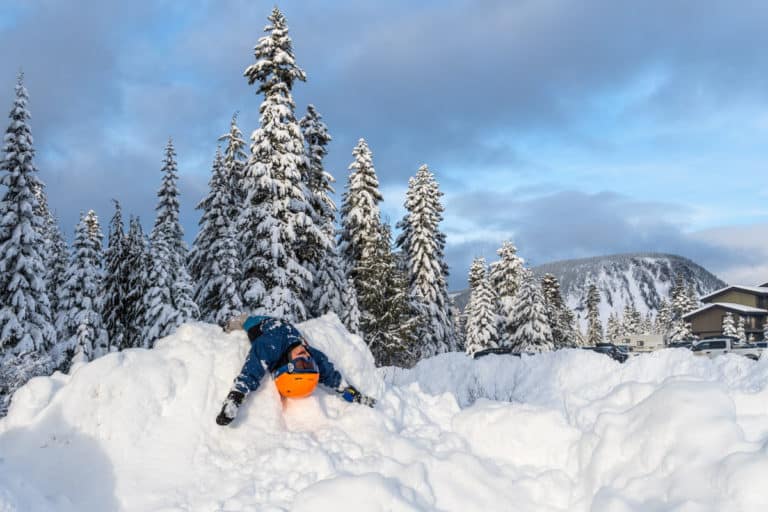When it comes to buying a snowboard, there’s a lot more to choosing the right board for you than you would probably think. Whether you’re a beginner on the slopes, or looking for your second (or tenth) board, in this post we’re going to cover what’s most important to look for when shopping.
I used to think a snowboard is a snowboard is a snowboard…right? Nope!
There are actually a ton of essential features to take into consideration when purchasing a snowboard. Believe it or not, there are a LOT of different types of boards. And, truth be told, if you end up loving snowboarding, you’re probably going to want to have a full quiver of boards for different days or conditions.
Case in point…
Me, when I first met my husband: “Why do you need another snowboard? You already have one.”
Me, now: “Hey babe? I think I need a more playful true twin to add to my quiver.” 😬
Thankfully, you don’t have to start with a full quiver. You can start with a solid board that has all the features you need for your ability level, riding style, and needs. After reading this post, you’ll have all the info you need to pick your next board – even if it’s your very first board.
And, then build up your collection from there (we won’t judge). 😉
Whether you’re looking for your first snowboard or adding a new one to your growing quiver, these are the essential things you need to take into consideration before you buy.
Type of Riding/Different Types of Snowboards
First, the kind of riding you plan to do will help dictate which type of snowboard you should purchase. There are essentially 5 different types of snowboards: all-mountain, freestyle, freeride, powder, and splitboards.
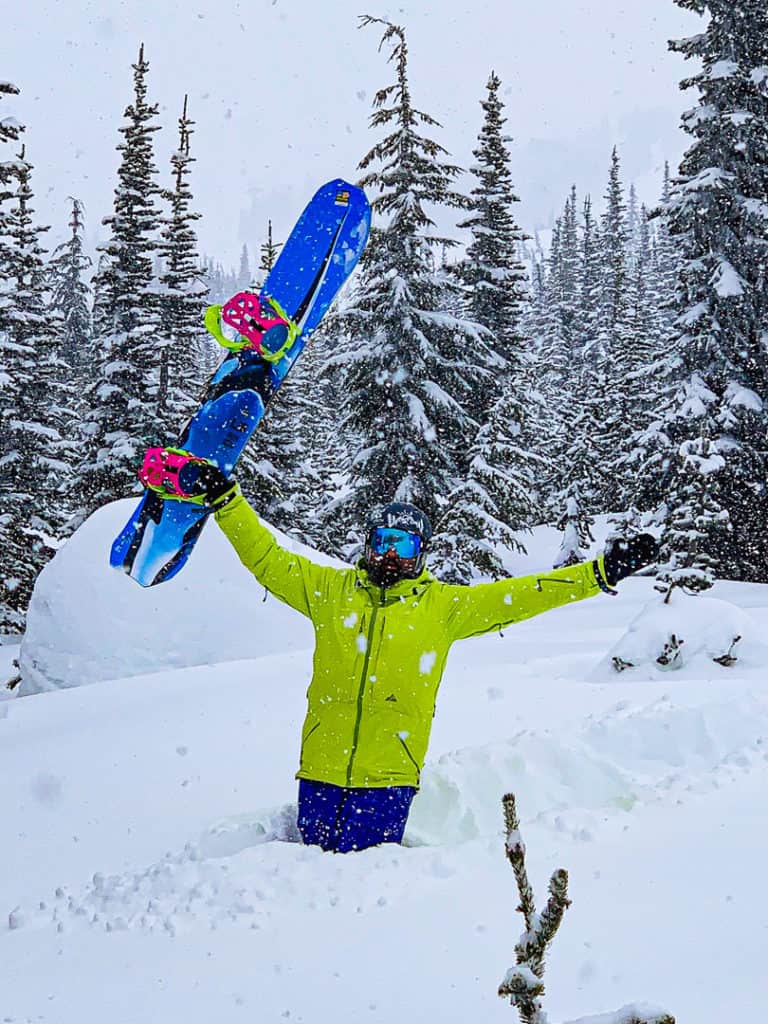
All-Mountain Snowboards
All-mountain snowboards are exactly what you’d think – a board that is versatile enough to handle the entire mountain – groomers, park, powder, and most everything else. While you can definitely find boards fine-tuned for riding specifically in one area of the mountain, all-mountain boards are great at handling it all.
Great for when you’re new to riding and plan to spend your time at a resort.
Here are some examples of great aIf you’re looking for a great choice for an all-mountain snowboards, here are some options to get you started:
Freestyle Snowboards
Freestyle snowboards are specifically designed for riders that plan to spend a lot of time in the park working on their skills. These boards will often be a twin profile and a shorter than an all-mountain board for the same size rider. This makes them more playful and easier to maneuver.
Great for when you plan to spend your time learning jumps, rails, and more in the terrain park.
Here are some great examples of freestyle boards:
Freeride Snowboards
Freeride snowboards are boards created primarily for riders who like to spend a lot of time exploring off the groomed runs. They are often directional boards that are longer than their freestyle counterparts.
Great for those who plan to spend a lot of time in ungroomed terrain.
Here are some great examples of freeride boards:
Powder Snowboards
Powder (“pow”) snowboards are boards created to float through deep snow easily. They often have a tapered design with a broader nose and a more narrow tail. Most of the time, the rider will be slightly set back towards the board’s tail to encourage float. Pow boards also tend to have a rocker profile.
Great for those who want to ride the deep stuff!
These are some of the powder snowboards we’d suggest checking out:
Splitboards
A splitboard is a snowboard that is designed specifically for riding in the backcountry. It is “split” lengthwise down the middle into two halves that allow you to add climbing skins for traveling uphill. You use special bindings that allow for uphill and downhill use.
Once you’ve climbed to the top, you put the two halves back together and readjust your bindings to ride down the mountain as you usually would. As your skill level improves, split boarding is another option for you to explore.
Splitboarding requires you to have avalanche awareness and skills to maintain proper safety in the backcountry, where there are no ski patrol to assist if things go awry. If splitboarding is in your future, here is a great place to start building your avalanche knowledge and sign up for a class.
Great for adventurous riders who love the challenge and beauty of the backcountry.
This is an excellent example of a splitboard.
Length
But, what about all those different lengths? How do you pick the right size snowboard for you?
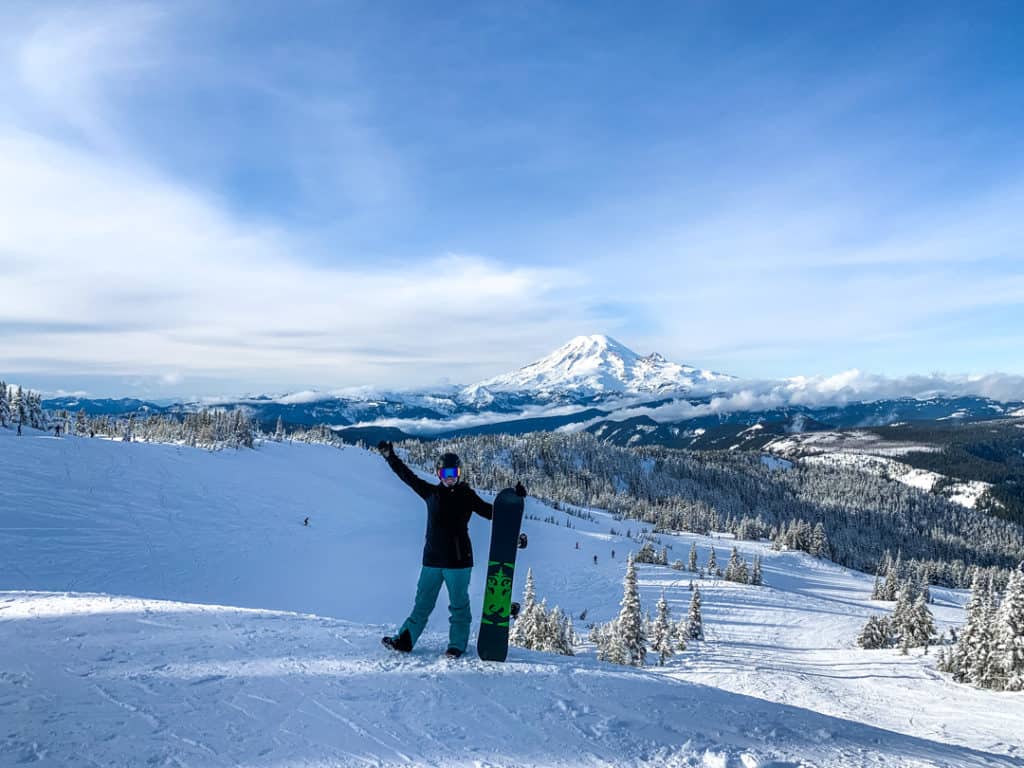
Well, the truth is that it depends. As we mentioned above in the snowboard types, each snowboard type can vary in typical size (shorter freestyle boards vs. longer freeride boards). So, the type of riding you’re going to do plays a role in what length of board you should choose.
Also, your height and body weight play a pretty significant role in which size you should choose. It used to be said that as a general rule, your snowboard standing next to you should hit somewhere between your chin and your nose. However, you’ll now find that following board manufacturer guidelines based on your height and weight is more accurate.
In addition to the type of snowboarding you’re doing and your size, you’ll also want to consider how stable you want your board to be. In general, a longer board has more of a connection with the snow and, therefore, will be more stable. However, it can also be more challenging to maneuver.
Ultimately, choosing your length is somewhat of a personal preference and the combination of the above factors. Remember that being comfortable on your board is really the most essential factor.
Width
snowboardAnother important factor when choosing your snowboard is ensuring that the board is wide enough (but not too wide) to properly fit your snowboard boots. Ideally, you’ll want your boots to just barely hang over the edge – just enough so that you can apply pressure easily to your edges (yay for edge control!), but not so far that your boots drag in the snow (boo for falling flat on your face!) When your boots drag in the snow, it is known as heel drag or toe drag.
Board Shape & Profile
When it comes to the shape of a snowboard, there are a few things to consider.
Shape
First, let’s talk about the actual shape of the board as you look at it from above while it’s lying flat on the ground.
True Twin Snowboards
Snowboards with a true twin shape are symmetrical. The tip and the tail are equal, and they can be ridden easily in either direction. The flex of the board in the core is also equal, no matter which direction you’re riding. This makes them great for beginners as well as those who plan to ride switch a lot.

Directional Snowboards
Directional snowboards are intended and designed to be ridden in one specific direction. They have a specific tip and tail. The tail is generally stiffer, and they often have a wider nose. You may also notice these boards have the rider set back slightly from the center of the board. It’s common to see pow boards as directional boards – the combination of a softer nose, set back stance, and wider nose helps you float better in the deep stuff.

Directional Twin Snowboards
As you might guess, directional twins like this one combine the above two shapes (directional and true twin). They can be symmetrical on tip and tail with a directional core, or they can have a directional tip and tail with an equal core. In addition, the stance might also be set back a bit. You can ride these boards switch, but you might notice some differences when you do.

Asymmetrical Snowboards
Asymmetrical snowboards have a shape that is different from the front to the back of the snowboard. Therefore, when riding an asymmetrical board, you will need to make sure you have a board designed for the direction you primarily ride – goofy or regular. The reason for this is that there is a distinct front edge and back edge designed to work with the asymmetrical shape of our bodies since your front doesn’t look like your back – right?!

Volume Shifted Snowboards
A volume shifted snowboard is one that maintains surface area with a short and wide shape instead of being long and narrow. They are more maneuverable in trees and can be a lot of fun to ride, especially in deep powder.
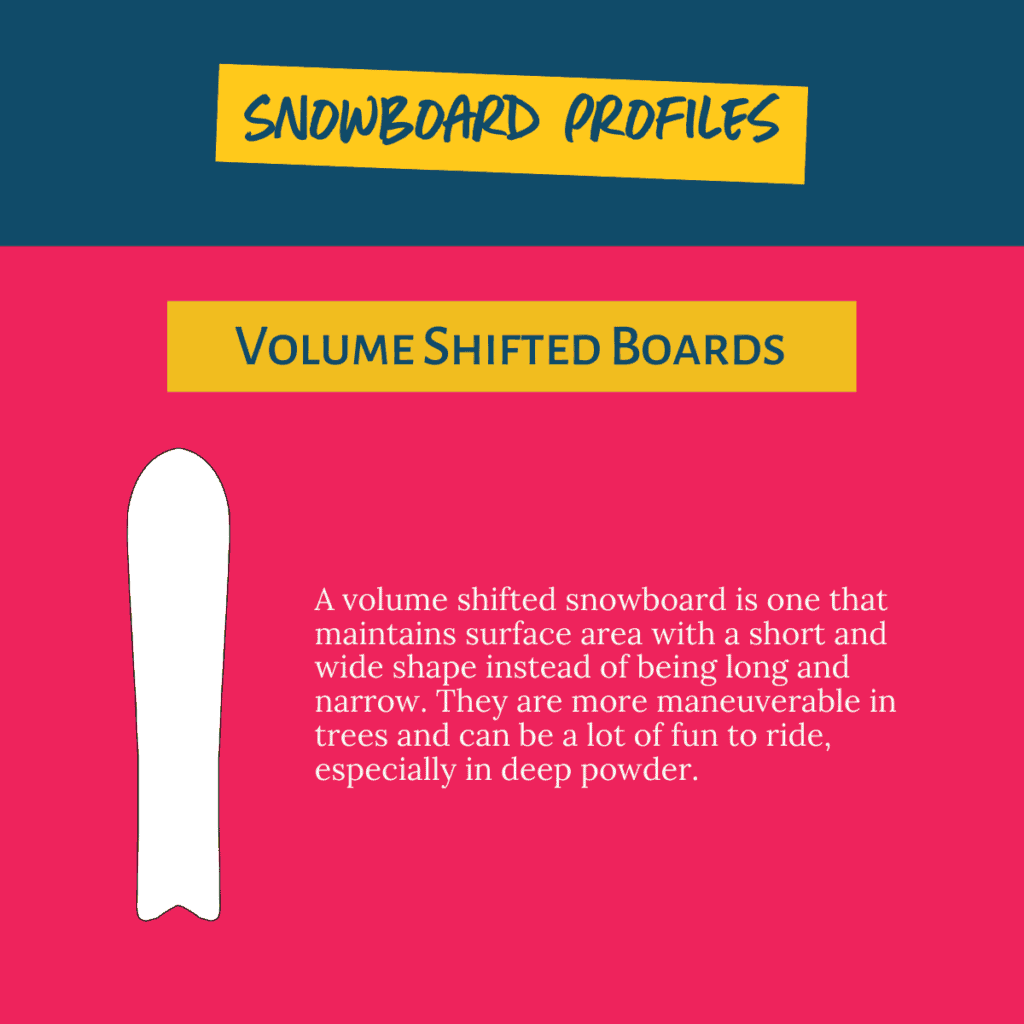
Rocker and Camber
Next is how your snowboard looks from the side as it rests on the ground (or if you hold it up and look down the edge of the board). There are essentially 3 main profiles – flat, camber, and rocker. However, manufacturers will often merge them in different combinations on a single board to enhance the riding experience.
Flat
A flat board is precisely what you would think – a board that lays flat on the ground. Flat boards are often recommended for beginners as they can be easier to maneuver and make initiating turns a little simpler. However, after the Burton Riglet, we moved both kids to a hybrid.
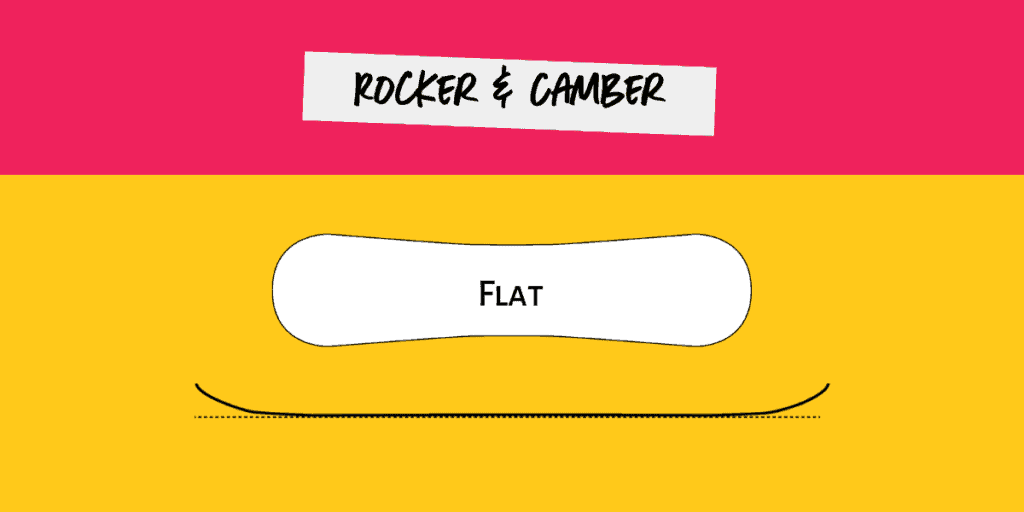
Camber
On a camber board, you’ll notice that if you place it flat on the ground, the center will lift away or rise off the ground. Camber is excellent for deep carving and generating big pop on jumps.
However, it requires a rider to be a little more confident in their turns – if you initiate a lazy turn on a camber board, you might find yourself on the snow. In addition, camber can also can provide more stability, power, and responsiveness.
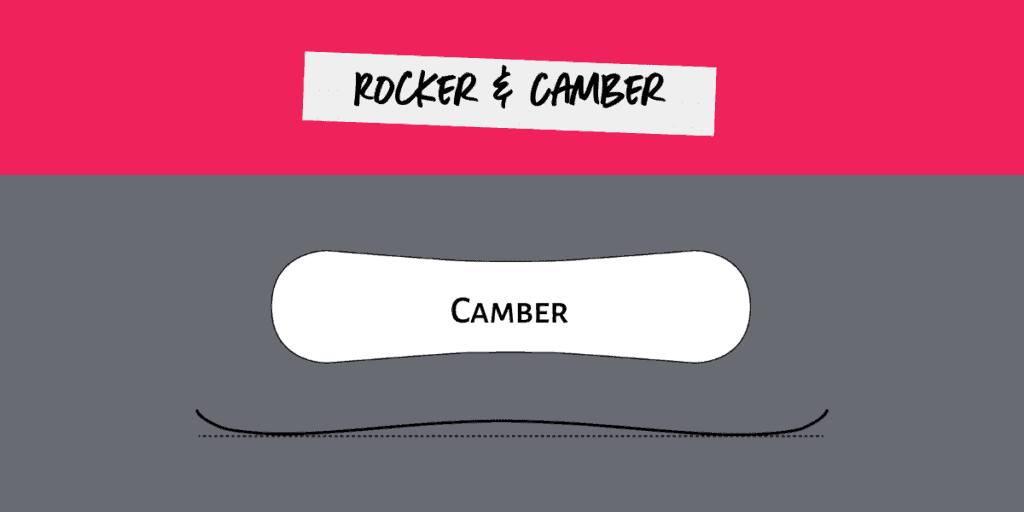
Rocker
With a rocker (or reverse-camber) profile, the center of the board will remain in contact with the ground, and the tip and tail of the board will be lifted or turned up from the ground. A rocker helps the board to float above the snow and makes initiating turns easier. The trade-off is that they can often feel less stable than a board with camber.
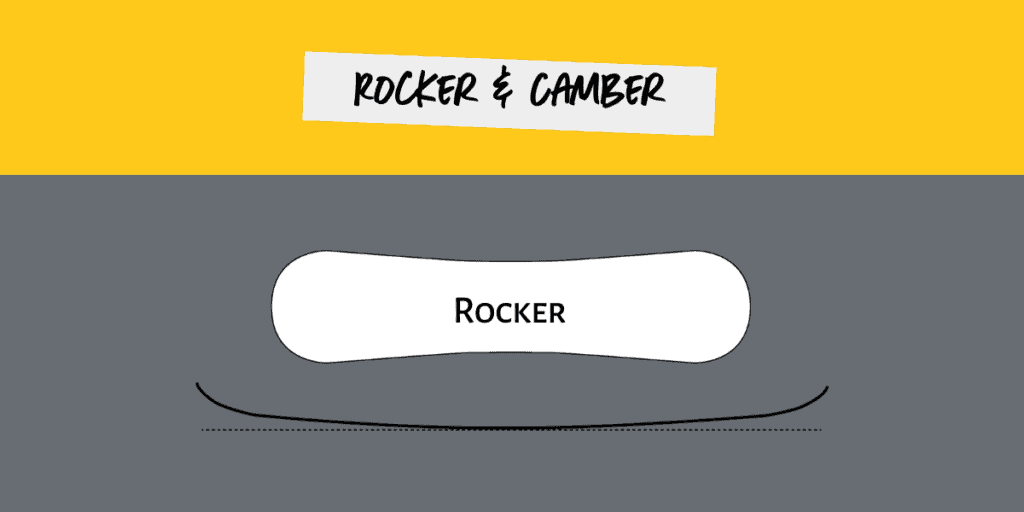
Hybrid Profiles
Hybrid profiles come in a wide variety of combinations from the above three main shapes. When looking for a board, you will find a TON of different options. Three of the more common options are camber/rocker/camber, rocker/camber/rocker, and rocker/flat/rocker. However, you’ll find many, many more than that.
If you’re new(er) to riding, boards with a mild rocker/camber/rocker (hybrid camber) profile can be a great place to start. You’ll feel more stable with camber under your feet, but the rocker at tip and tail will help you initiate turns and maneuver more easily.
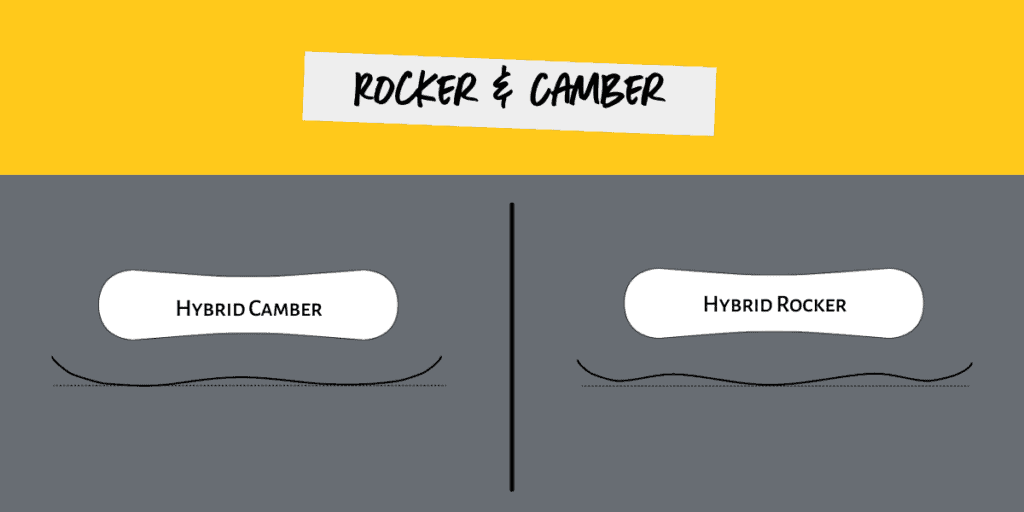
Flex
The flex of a snowboard can tell you how stiff or how flexible a board is. Most manufacturers use a rating scale of 1-10. This is usually used primarily as a guide to tell you where the board falls on the 1 (soft) -10 (stiff) scale. Within a brand, you’ll be able to compare boards using this scale. However, keep in mind that not all brands are apples to apples. For instance, a 7/10 from Jones may be different than a 7/10 from Burton.
If you are new to riding, lightweight, or plan to spend a lot of time in the park, softer rides are generally preferred. For heavier riders or those who want excellent edge control (or better edge hold) and more stability, a stiffer ride is often the choice.
Binding Type
One last thing to keep in mind when purchasing a snowboard is that there are different types of binding mounting systems as well. Most brands use a 4×4 or 2×4 mountain plate. However, Burton also has a 3D and Channel system (and they have licensed it to some other manufacturers). Although most boards will work with most bindings, especially with a universal plate, it’s a good idea to double-check compatibility before you purchase.
Other Factors to Consider
Though the features above are the most important when choosing a snowboard, other factors can affect your board’s ride, durability, and compatibility. If you’re ready to dig in a little deeper before making your final selection, here are some additional specs to research on your potential new snowboard.
Sidecut Radius
Remember geometry? Yeah, me neither. 🤪 In simple terms, the sidecut radius refers to the curve along the side of the board. This curve (how short or how long it is) will determine whether the board is best at tight or wide turns.
For example, in boards with a shorter sidecut radius, it is often easier to make tight turns. A larger sidecut radius generally means that the board excels at longer arching turns.
Effective Edge
Although your snowboard might be 151 cm, the effective edge (the edge that actually comes into contact with the snow while you ride) is shorter than the full length of your board. This is typically due to the rise at the tip and tail of the snowboard.
When choosing a board with a longer effective edge, you can expect it to offer more stability and grip. A shorter effective edge, in contrast, may feel less stable but will be easier to maneuver.
Base Material
In addition to snowboard type and shape, another factor to consider when making a purchase is the kind of base on the board. There are two main types of bases – extruded and sintered.
In general, extruded bases tend to be less expensive. They are durable and, if repair is needed, are typically easier to repair. However, they do not hold wax as well as a sintered base and can be slower on the snow.
Sintered bases, on the other hand, will absorb wax more easily than an extruded base. You can glide across the snow much faster with this kind of base when they are properly waxed and cared for. However, they are also generally more expensive to purchase and more difficult to repair.
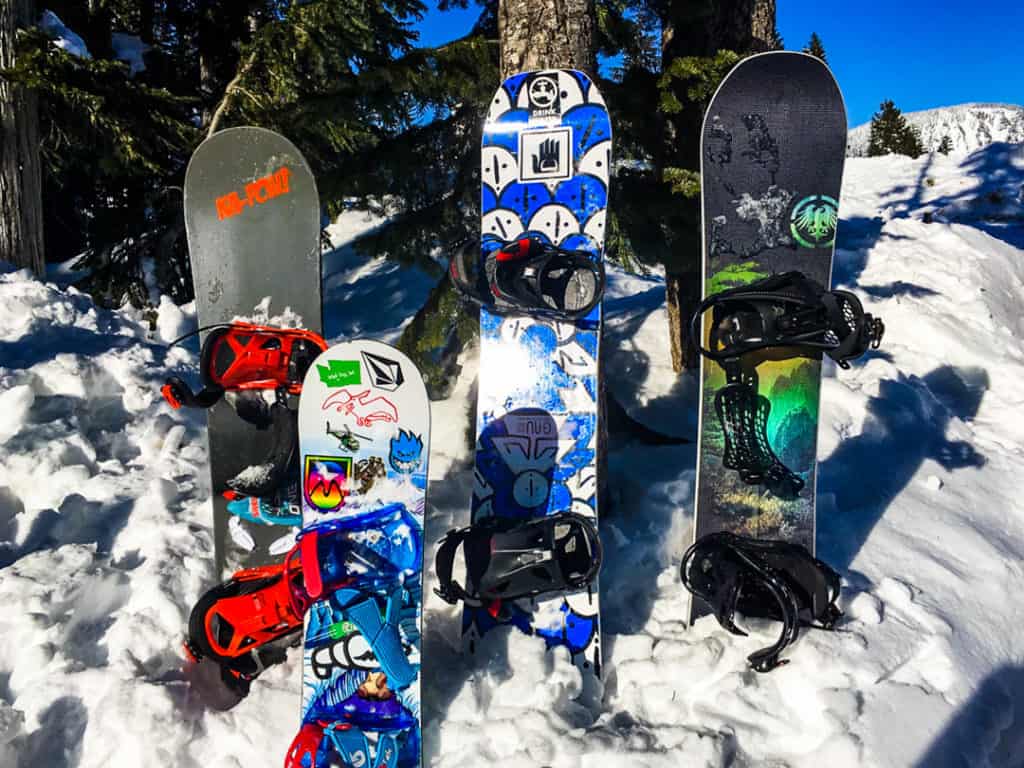
Frequently Asked Questions About Buying a Snowboard
What should I look for when buying a snowboard?
When looking for a snowboard, the 5 biggest factors to consider are: Type of Riding, Length, Width, Shape & Profile, and Flex. After that, you may also want to consider these additional features.
What is the best all-around snowboard?
What are the four types of snowboards?
The main types of snowboards are all-mountain, freestyle, freeride, powder, and splitboards.
How much should I spend on my first snowboard?
You should expect to spend $300-500 on your first high-quality, new snowboard. However, if you watch for sales or gently used boards, you can often find deals that bring the cost down significantly.
You’ll need to plan for additional costs, such as bindings and boots, as well. Some shops will offer package deals with everything at a discount, like these. If you find the right combination for you, the cash savings can be huge.
In addition, if you think you’ll want a new board for next season, keep your eyes out for sales like these – especially in spring and summer. We’ve scored some killer deals at the end of the season on premium boards by doing this.
How long do snowboards last?
A long time. If you take care of your boards with proper maintenance, tune-ups, and storage, you can expect hundreds of days out of one board. Because most people ride only a handful of days per year, this can translate to years of use. Manufacturer statements will vary anywhere from 75-200+ days before they need to be replaced.
That said, if you are rough on your snowboard, don’t tune them up when needed, or end up taking damage from rocks/trees/etc., how long it lasts can change dramatically.
Is it better to rent or buy a snowboard?
The answer is, it depends. Honestly, if you’re heading out for your very first time or two and aren’t sure if you’ll enjoy snowboarding, it’s probably better to rent. Some shops even offer season-long rentals, which can be great for growing kids or adults just getting started.
But, once you know you enjoy riding, you’ll end up saving money in the long run by purchasing your own setup.
Are used snowboards worth it?
They can be! You’ll want to do your research on that particular board, ask plenty of questions, and check it out carefully for damage. However, we have gotten some fantastic deals on lightly used boards. In addition, we’ve sold boards that didn’t work for us at a deep discount.
What is goofy and regular? Does my stance matter when buying a snowboard?
Goofy and regular refer to which foot you place further towards the front (tip) of your board, as well as the foot that leads down the mountain.
For instance, a regular rider will put their left foot towards the front of the board. Their right foot is their back foot, and the foot they will unstrap to skate when in the chair lift line. A goofy rider is the opposite – their right foot is towards the front of the board, and they skate with their left.
When buying most snowboards, your stance doesn’t matter as they are easily swapped back and forth. The exceptions are certain asymmetrical boards that are manufactured based on stance.
Final Thoughts on Buying a Snowboard
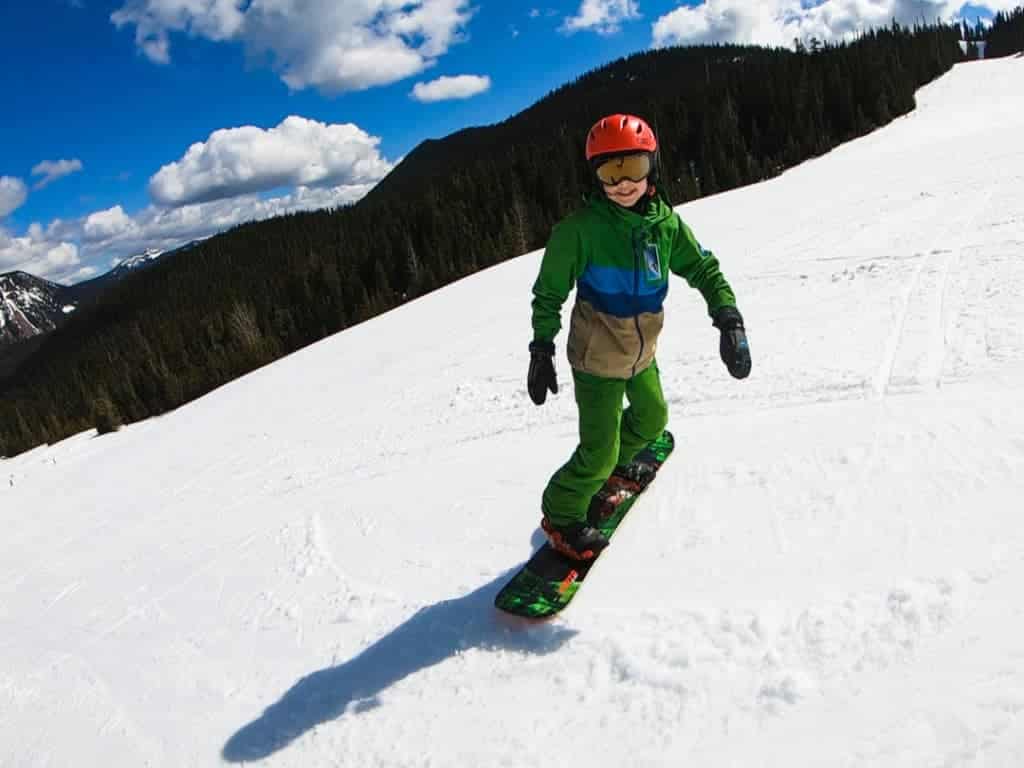
There’s no one-size-fits-all snowboard for everyone. However, when you’re figuring out how to choose a snowboard, focus on the kind of riding you like to do and the conditions you’re likely to be snowboarding in to help guide your decision. The most important thing to remember is that it’s all about getting out there and having fun.
If you’re still on the fence, check with local shops or mountains to see if they offer demos of the boards you’re considering and give them a try. A couple years ago, a demo day on a Never Summer Aura solidified that it was the board I wanted to buy – it’s still my top pick out of all my snowboards 90% of the time!
Have more questions about choosing your perfect board? Ask away in the comments!

